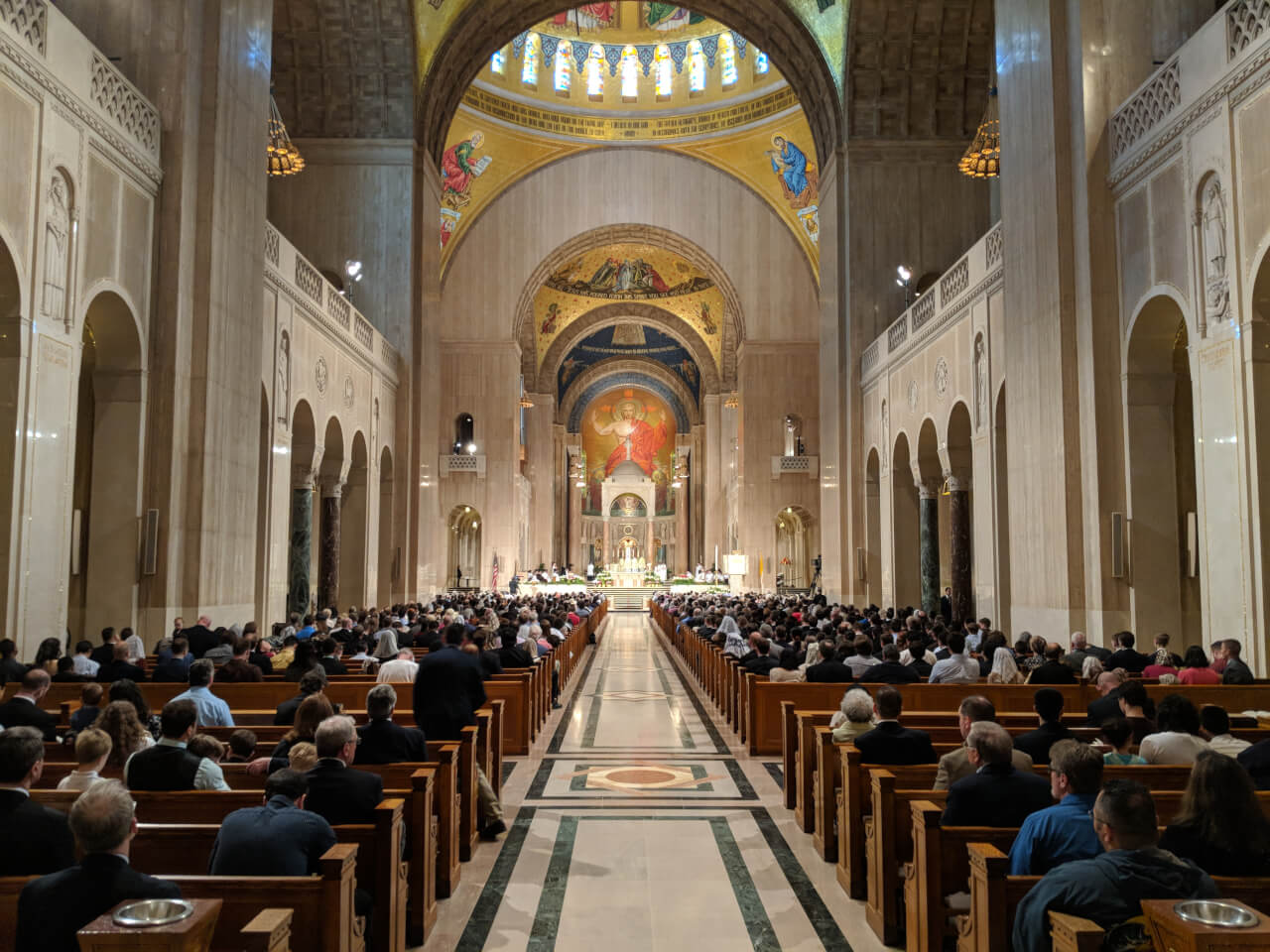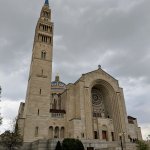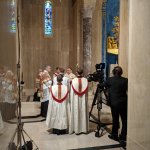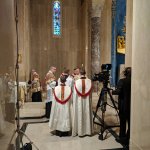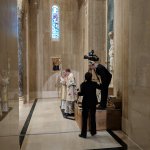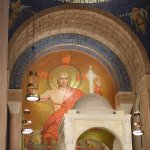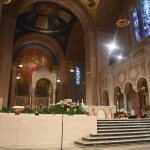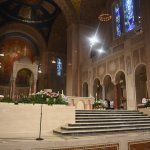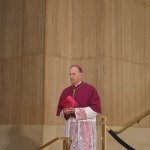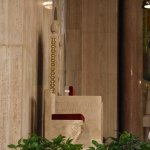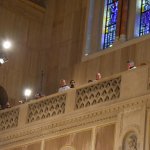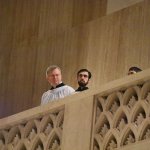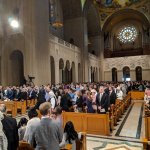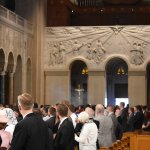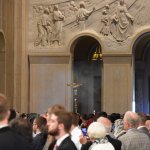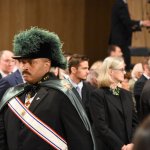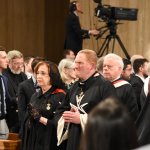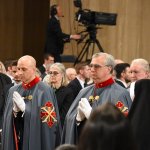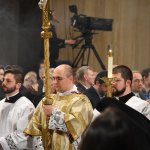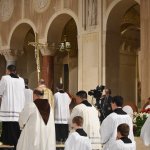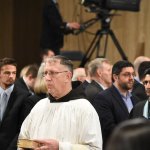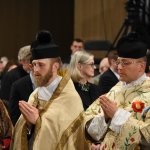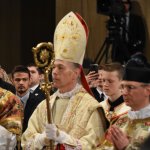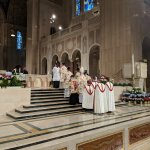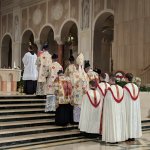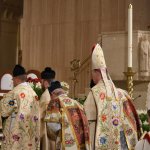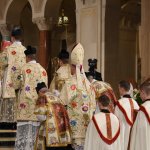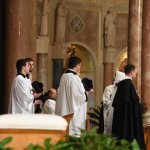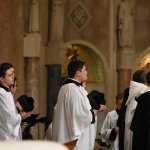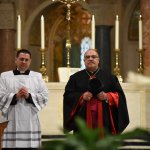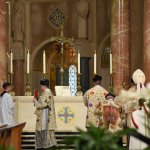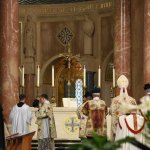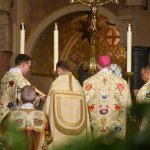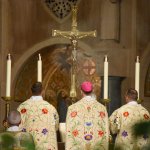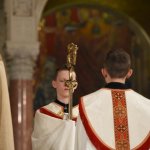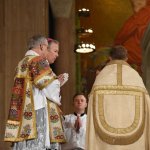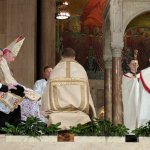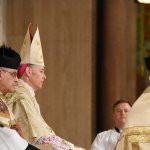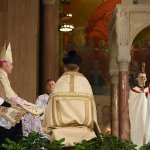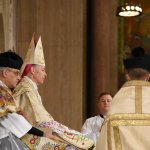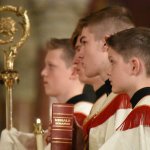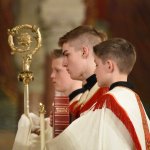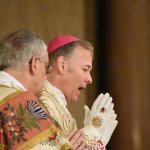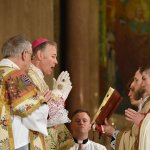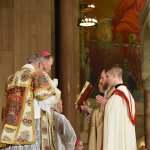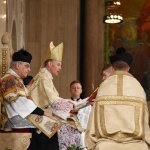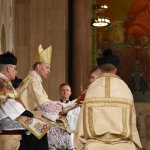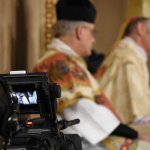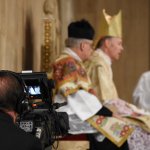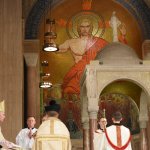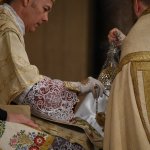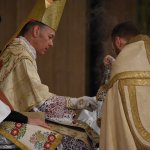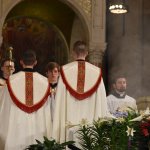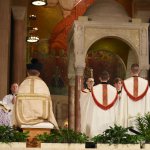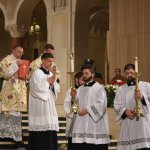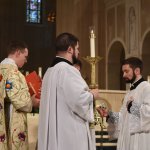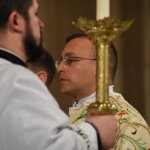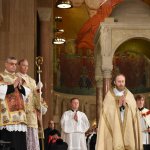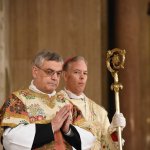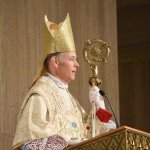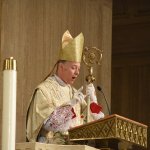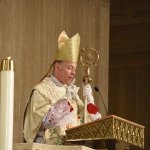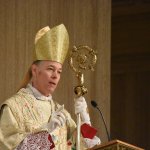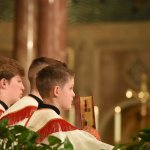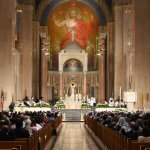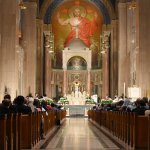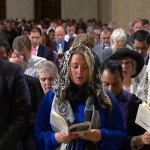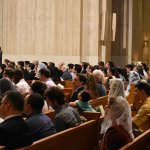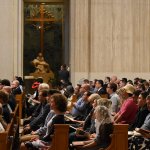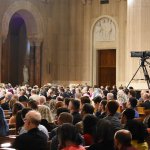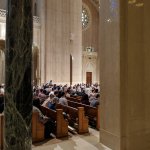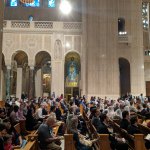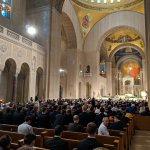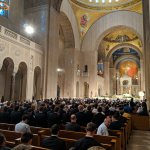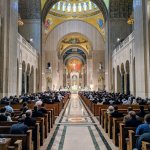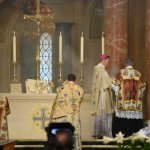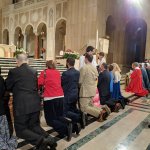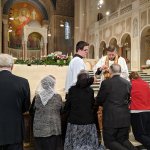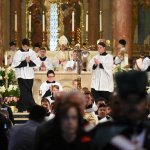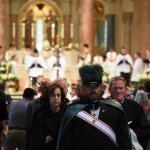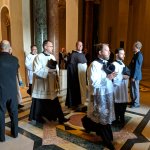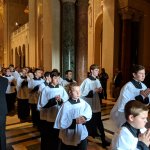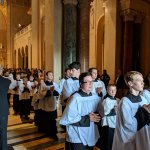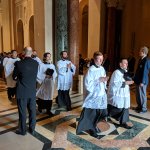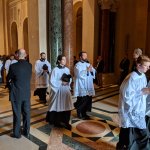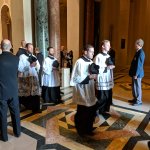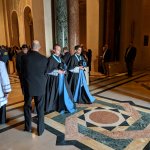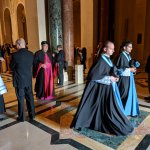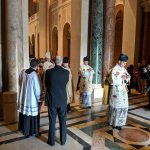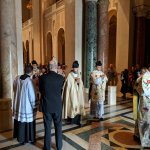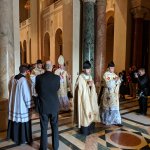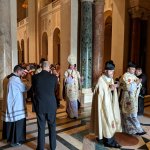I spent last Saturday in DC, attending the Pontifical High Mass offered by Archbishop Sample of Portland, Oregon, in thanksgiving of the tenth anniversary of Summorum Pontificum. The last time such an event was held in main body of the largest Catholic church in the United States, the year was 2010.
On this occasion, it was a beautiful Spring day in the nation’s capital, and the upper church began filling early. I spent my first our on scene in line for confession, and only thanks to the gracious assistance of a friend, had a reserved seat in the front row of the Basilica for the main event.
Attendance was good — I’ve heard estimates ranging in the neighborhood of 1500 to 4000 people. My personal guess would be about 2500, since the seating capacity of the upper church is 3500 and mid-Mass, this was the scene from the narthex:
The pews weren’t filled to the brim, but there were people throughout the whole church. All in all, I’m happy with the turnout.
The Mass was well executed, with a vertiable army of altar servers and priests in choir. Among the notable clergy who participated in the liturgy were several priests from the Priestly Fraternity of St. Peter, including Fr. Joseph Bisig, who co-founded the Fraternity and served as its first Superior General. Clerics were also present from the Institute of Christ the King, Sovereign Priest, including provincial superior Canon Matthew Talarico. Maronite chorbishop Anthony Spinosa was also seen in attendance. Also spotted was Dom Daniel Augustine Oppenheimer, prior of the Canons Regular of the New Jerusalem. Honestly, there were so many clergy present I feel as though I’m doing them all a disservice by mentioning just a few.
The music was excellent, and was performed variously by the Scholas of The Lyceum School in South Euclid, Ohio, St. John the Baptist in Allentown, New Jersey, and St. Mary, Mother of God in Washington, DC, as well as by the Choir of the Basilica of the National Shrine of the Immaculate Conception. Selections included pieces by Tomas Luis de Victoria, Claudio Monteverdi, and Thomas Tallis, among others.
I took a number of photos for the event (which you are welcome to use if you credit me as the photographer with a link to this post):
Archbishop Sample’s homily was a rousing tribute to Summorum Pontificum, and he highlighted the youth presence at the Mass:
As we gather here today in this magnificent basilica, one cannot help but notice the very large presence of young people who have come to participate in this Holy Mass. I have met a good number of you personally. You are a sign – a great sign – of encouragement and hope for the Church tossed about these days on the troubled waters of secularism and relativism. As they say, you “get it”. You understand your place in the world and in the Church to help rebuild a culture of life in society and a renewal of Catholic culture within the Church herself.
Over the years since the release of Summorum Pontificum, I have heard many in the Church – including priests and bishops – express puzzlement and dismay over why so many young people are attracted to this venerable form of the Roman Rite. They say things like, “I just don’t understand. How could they be so attracted to a form of the liturgy that they did not grow up with or ever experience before?” If the comment has been directed to me, I have often responded “That is exactly the question you should be asking. Why are they attracted to this liturgy? Or perhaps more pointedly. What is it that this form of the Roman Rite provides for them that their own experience growing up with the Ordinary Form did not provide? For this will give us an insight into what future liturgical development might look like.”
[…]
So many young people have discovered this form of the sacred liturgy as part of their own Catholic heritage. I myself first discovered the traditional Latin Mass as a college student. I came across it. But for me it was an historical relic and something that I never imagined that I would actually experience. Maybe the experience of these young people growing up with the Ordinary Form did not carry with it the beauty reverence prayer fullness sense of mystery and transcendence or wonder and awe that the traditional Latin Mass has provided for them. Perhaps this is the answer to the question posed above about why so many young people are drawn to the Holy Mass celebrated according to the 1962 missal.
Where I would digress from the Archbishops’ thoughts somewhat was in his insistence that he was not “calling into question the legitimacy the validity or even the goodness of the missal promulgated by Blessed Paul VI” or in his emphasis on Benedict XVI’s insistence that there is “no contradiction between the two editions of the Roman Missal. In the history of the liturgy, there is growth and progress, but no rupture”. I think that most of us in the liturgical trenches not only question the “goodness” of the missal of Paul VI, but know very well by experience that there was indeed rupture — and that the so-called “hermeneutic of continuity” is, sadly, little more than wishful thinking.
That said, this was a Mass broadcast live on EWTN (see the video below) for an audience that one can only expect has been left largely unexposed to the beauty of the Church’s ancient liturgy or the deep theological and anthropological contrasts that exist between it and the new rite. On the whole, I found the Archbishop’s homily to be a good one, even if I eagerly await the day when the Second Vatican Council is no longer viewed as the mandatory reference point for all things by even our best prelates.
The video below offers the full broadcast of the Mass from EWTN with commentary from Msgr. Charles Pope and Msgr. Andrew Wadsworth. Beneath that, I’ve included a separate audio file and transcript of Archbishop Sample’s homily.
All told, this was an uplifting and hope-filled event, and I hope that we won’t have to wait another eight years for the next one. My gratitude goes to The Paulus Institute for making the liturgy happen, to Archbishop Sample for agreeing to offer the Mass, and to all the priests, deacons, seminarians, schola and choir memers for making it such a memorable event.
Thanks also go to each and every attendee — many of them pilgrims coming from far away — for filling the pews and making such a powerful statement about our love for the Church’s venerable Latin liturgy.
I had the misfortune of sitting directly in front of one of the EWTN cameras for the whole Mass, so I apologize in advance to the viewing audience:
Archbishop Sample’s homily (audio):
Transcript:
[00:00:00] In the name of the Father and of the son of the Holy Spirit.
[00:00:06] My dear brothers and sisters in the Risen Lord it is with the greatest joy that I gather with all of you this day in this beautiful National Shrine dedicated to our Blessed Mother under her title The Immaculate Conception – the patroness of our great country. We are in Mary’s shrine and we are all filled with gratitude and joy. We celebrate today this Holy Mass in honor of the Immaculate Heart of the Blessed Virgin Mary. We are all sinners yet in her Immaculate Heart we find refuge, consolation, protection, strength, and the love of her motherly embrace.
[00:01:31] Just as Holy Mary stood at the foot of the cross of our Divine Savior where her heart was pierced with the sword of sorrow. So she stands by us today, and at the foot of this altar as we sacramentally re-present the once-for-all sacrifice of Christ.
[00:02:07] As the Second Vatican Council’s document on the sacred liturgy reminded us — referencing the teachings of the Council of Trent — Christ who formally offered Himself in a bloody manner on the altar of the Cross is now offered in a sacramental and and unbloody manner in the Holy Sacrifice of the Mass. And His Holy Mother joins with us in this offering in the great communion of all the saints.
[00:02:55] We also gather to celebrate the tenth anniversary of the great gift our beloved Pope Emeritus Benedict XVI left to the Church in his motu proprio, Summorum Pontificum. Dear Holy Father, I know I speak on behalf of all gathered here, those watching this broadcast live through EWTN, and many others when I say thank you for your wisdom, foresight, and pastoral generosity in allowing the usus antiquior of the Roman Rite to once again flourish in the Universal Church.
[00:03:54] As we gather here today in this magnificent basilica, one cannot help but notice the very large presence of young people who have come to participate in this Holy Mass. I have met a good number of you personally. You are a sign – a great sign – of encouragement and hope for the Church tossed about these days on the troubled waters of secularism and relativism. As they say, you “get it”. You understand your place in the world and in the Church to help rebuild a culture of life in society and a renewal of Catholic culture within the Church herself.
[00:05:04] Over the years since the release of Summorum Pontificum, I have heard many in the Church – including priests and bishops – express puzzlement and dismay over why so many young people are attracted to this venerable form of the Roman Rite. They say things like, “I just don’t understand. How could they be so attracted to a form of the liturgy that they did not grow up with or ever experience before?” If the comment has been directed to me, I have often responded “That is exactly the question you should be asking. Why are they attracted to this liturgy? Or perhaps more pointedly. What is it that this form of the Roman Rite provides for them that their own experience growing up with the Ordinary Form did not provide? For this will give us an insight into what future liturgical development might look like.”
[00:06:38] Now I do not want to be misunderstood. I am not at all calling into question the liturgical reform that was actually called for by the Second Vatican Council. Nor am I calling into question the legitimacy the validity or even the goodness of the missal promulgated by Blessed Paul VI. But perhaps in the actual implementation of the council’s directives not everything that occurred has borne good fruit. And certainly through liturgical abuses other aberrations or simply a poor ars celebrandi the Ordinary Form of the Roman right has too often been disfigured and has been experienced as a rupture with our liturgical past.
[00:07:54] So many young people have discovered this form of the sacred liturgy as part of their own Catholic heritage. I myself first discovered the traditional Latin Mass as a college student. I came across it. But for me it was an historical relic and something that I never imagined that I would actually experience. Maybe the experience of these young people growing up with the Ordinary Form did not carry with it the beauty reverence prayer fullness sense of mystery and transcendence or wonder and awe that the traditional Latin Mass has provided for them. Perhaps this is the answer to the question posed above about why so many young people are drawn to the Holy Mass celebrated according to the 1962 missal.
[00:09:09] Pope Benedict XVI referenced this in his letter to the world’s bishops which accompanied the release of Summorum Pontificum. In speaking of Pope St. John Paul’s own efforts to pastorally provide for those attached to the traditional liturgy — which the saintly Pope did through his own motu proprio, Ecclesia Dei, in 1988 — Pope Benedict wrote this: “Immediately after the Second Vatican Council it was presumed that requests for the use of the 1962 missal would be limited to the older generation which had grown up with it. But in the meantime it has clearly been demonstrated that young persons too have discovered this liturgical form, felt its attraction, and found it a form of encounter with the mystery of the most Holy Eucharist particularly suited to them. Thus the need has arisen for a clearer juridical regulation which had not been foreseen at the time of the 1988 motu proprio.”
[00:10:40] Now, I don’t want to forget that older generation of Catholics who have remained attached to this ancient liturgy. You are important as well. This is the Mass of the Ages that has nourished the faith life of generations and generations of Catholics — including my parents’ generation. I often think about that. This is the mass that my grandparents participated in. This is the Mass that nourished the faith and devotion of my mother growing up. God rest her soul. This is the mass that drew my father to the Church and helped fuel his conversion. This is the mass that has produced saints.
[00:11:53] I believe one of the most important phrases in the letter of Pope Benedict XVI referenced above is this: “There is no contradiction between the two editions of the Roman Missal. In the history of the liturgy, there is growth and progress, but no rupture. What earlier generations held as sacred remains sacred and great for us too, and it cannot be all of a sudden entirely forbidden or even considered harmful. It behooves all of us to preserve the riches which have developed in the Church’s faith and prayer, and to give them their proper place.”
[00:12:53] As we continue our celebration of the tenth anniversary of Summorum Pontificum, I wish to touch upon one final point. This has to do with the positive motivation of the pope emeritus in issuing the motu proprio. He said that it is a matter of coming to an interior reconciliation in the heart of the Church.
[00:13:29] During my ad limina visit to Rome in the year 2012, and during our visit with Pope Benedict XVI, I had the opportunity to thank him for the gift of Summorum Pontificum. He responded at length to my intervention beginning by saying that he had issued the Mmotu proprio in order to reconcile the Church with her past. This reconciliation the pope emeritus spoke of involves learning from the experience of the Sacred Liturgy according to the usus antiquior in order to better inform and shape our understanding and celebration of the newer Roman Rite. With both liturgies flourishing side by side, there could be a mutual enrichment of the two forms of the one Roman Rite, perhaps leading to further liturgical development and progress. After mentioning some ways in which the Roman Missal of 1962 could be enriched by the newer Roman Missal, Pope Benedict said this about how the more ancient form of the liturgy could enrich the newer form: “The celebration of the Mass according to the missile Paul VI will be able to demonstrate more powerfully than has been the case hitherto the sacrality which attracts many people to the former usage.
[00:15:20] The most sure guarantee that the Missal of Paul VI can unite the parish communities and be loved by them consists in its being celebrated with great reverence in harmony with the liturgical directives. This will bring out the spiritual richness and the theological depth of this missal.
[00:15:43] I believe this is a key to interpreting Pope Benedict XVI’s desire, namely, that the flourishing of the more ancient form of the liturgy with its beauty reverence and sacredness will cause a natural development and enrichment of the way in which the newer Mass is celebrated. As he says there cannot and should not be a rupture between the two forms one must be able to recognize the older Roman Rite in the newer. I often get the impression that many people in the church live their lives as if the church sort of hit a reset button at Vatican II, and that the past no longer has relevance especially regarding the Sacred Liturgy. There must be further liturgical growth and development along the lines of a hermeneutic of continuity with the past and any experience of rupture must come to an end. May it be so.
[00:17:03] And so my dear brothers and sisters, let us give thanks to God for the life, pastoral ministry, and courage of Pope Emeritus Benedict XVI. Let us thank the Lord for both Pope Benedict’s gift to us — the greater celebration and availability of the usus antiquior of our common heritage in the Roman Rite. Let us pray for Pope Benedict XVI that the Lord grant him peace and joy during the time the Lord allows him to be on this earth praying and sacrificing for us. We take our prayers in gratitude now to that greatest of all acts of thanksgiving: the celebration of the Most Holy Eucharist.
[00:17:59] Let us go unto the altar of God.
[00:18:02] In the name of the father and the son and of the Holy Spirit.

